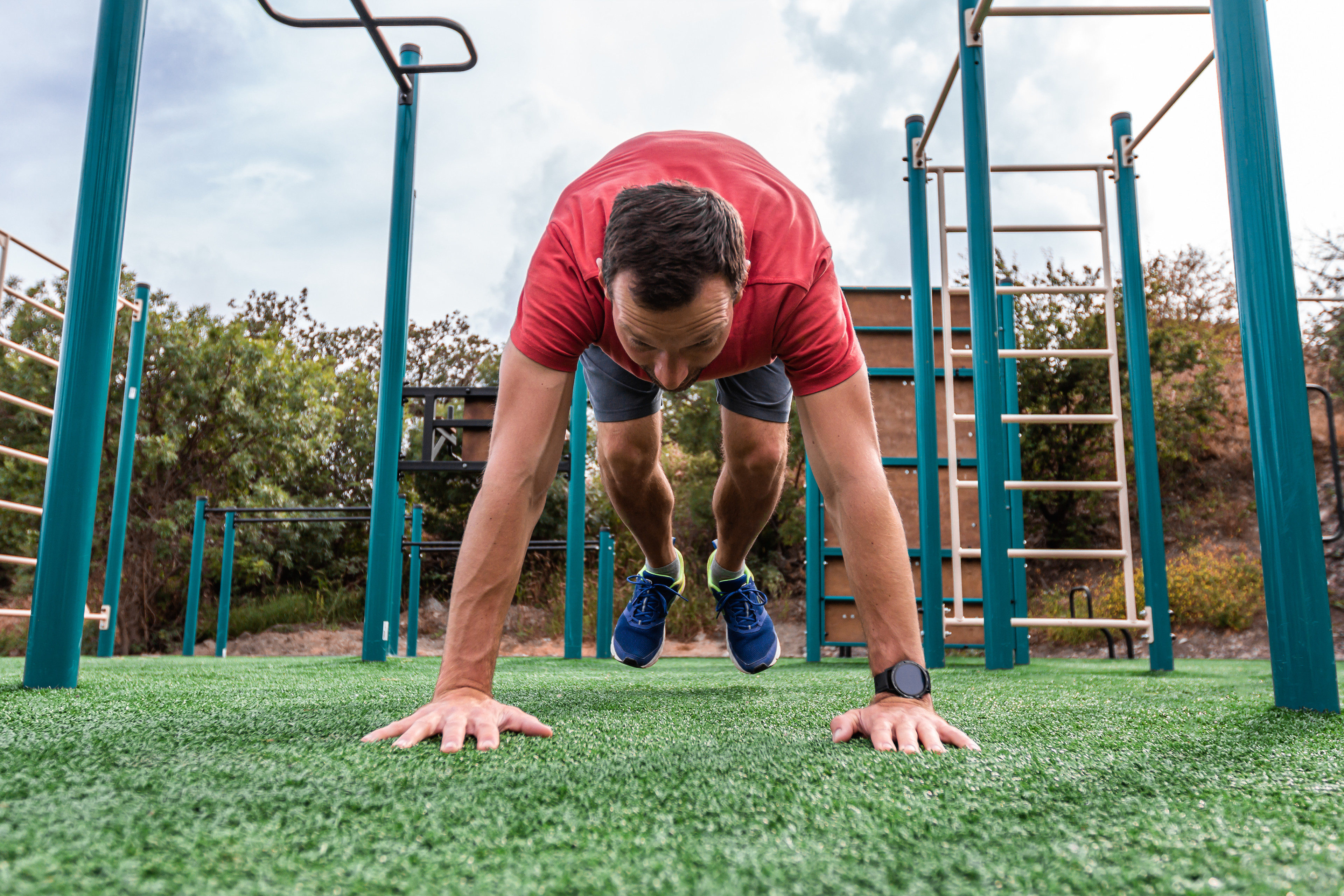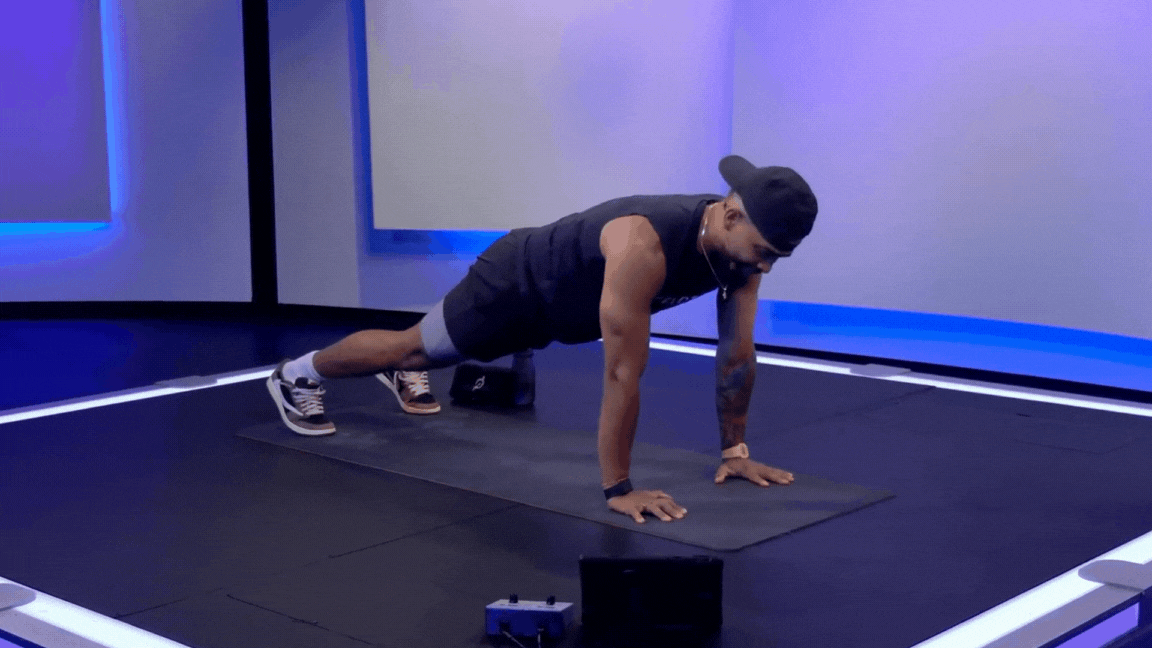
rbkomar/Moment via Getty Images
How to Do a Burpee with Perfect Form
Quality over quantity is key for burpees—here’s how to master them.
By Angelica Wilson•
Benefits of Burpees
How to Do a Burpee with Perfect Form
What Muscles Does a Burpee Work?
Common Mistakes When Doing Burpees
Burpee Modifications: How to Make Burpees Easier
Burpee Variations: How to Make Burpees More Challenging
Love it or hate it, the burpee is one of the most physically demanding exercises to exist. Why? It’s a compound aerobic exercise that targets every major muscle group in the body. The burpee’s ability to serve as both a cardio and strengthening exercise makes it an effective workout in of itself. And, it makes for a fiery finisher to any sweat session. “A burpee is a dynamic exercise where you lie down flat on the floor and jump back up at speed,” says Peloton instructor Joslyn Thompson Rule. The frequent level changes combined with coordination—challenging movements and quick repetitions will leave you breathless—in the best way.
Benefits of Burpees
Although it’s a challenging move, mastering burpees is worth the effort. “To start, it is a quick and easy way to increase the heart rate quickly,” Joslyn notes. By continuously, and strategically, moving your entire body you’re increasing your cardiovascular endurance, heightening your overall coordination, and gaining strength through this aerobic exercise.
However, Joslyn warns that the benefits only come when the compound exercise is performed correctly. “It is a good conditioning exercise, which it can be for those who can perform them safely, but it is not superior to other plyometric exercises,” she says.
How to Do a Burpee with Perfect Form
To do a burpee with perfect form, it helps to understand all the different parts of a burpee. The four parts are squat thrust, plank, push-up, and jump squat. But, before you start, make sure that you’ve already completed a warm up. “You should be fully warmed up ahead of doing [your burpees],” Joslyn instructs. The Peloton instructor recommends performing the compound exercise towards the end of your workout to avoid fatigue early on in your workout.
Then, as you start to try out the cardio-heavy exercise, move slower than you want to in order to focus on your form. When it comes to burpees, Joslyn emphasizes form over speed. By moving at a slower pace, you can focus on engaging the right muscles at the right time to avoid achy post-workout joints.

Step 1: Squat Thrust
Start standing with your feet hip-width apart. Next, engage your core by knitting the ribs.
Then, keep your spine long and core engaged as you bend the knees to sit into a squat with your hips landing slightly above the line of your knees.
To add the thrust, keep your core engaged as you reach the hands towards the ground with soft elbows and jump into a plank. As your hands land, keep your elbows closer to the ribs.
Step 2: Plank
Keep your fingers spread wide, grip the ground as if you were trying to pick up sand in your hands.
Press the ground away to keep your heart in line with your shoulders. Maintain your engaged core.
Engage your quads as the legs lengthen.

Step 3: Push-up
Maintaining the plank position from shoulders to toes, bend the elbows back (keeping them a bit close to the ribcage) and lower your chest to the floor without losing the engagement of your core and thighs.
Then, on a breath out, press into your hands to return to a plank position.
Step 4: Jump Squat
From plank, keep your core engaged as you bend the knees slightly.
Then, jump the feet forward towards the hands to land in your squat.
Next, jump up in the air while reaching your arms overhead for added momentum.
Land in your starting position–with knees soft–to complete the rep.
What Muscles Does a Burpee Work?
Burpees are a full-body exercise, so several muscle groups are being worked at the same time with each step of the compound exercise. The squat thrust to plank targets the quads, glutes, hamstrings, and core during the first part of the movement. Then, as your hands touch down, the chest and triceps chime in.
By the time you’re in a plank, you’re channeling the whole body. That includes the core and deltoids, along with the entire upper and lower body–even down to the muscles in your feet. Next, during the push-up, you’re working all of the same muscles as the plank with the addition of your biceps. Lastly, the jump squat works your glutes, quads, hips, and hamstrings.
Common Mistakes When Doing Burpees
With the complexity of this aerobic exercise, form mistakes are bound to happen. Joslyn says that one of the most common mistakes is “overarching through the back when jumping into the plank.” To help correct this, the Peloton instructor suggests practicing landing in a strong plank without letting the hips dip towards the ground.
Another common mistake is doing too many burpees. (Yes, there’s such a thing as too many.) “An excess number of burpees will cause undue fatigue which may impact form on other exercises as well as reduce form in the burpees themselves,” Joslyn explains. “I would prioritize form over volume/number of repetitions here.”
Burpee Modifications: How to Make Burpees Easier
There are several scenarios where you’ll want to ease up on your burpees. If you’re new to burpees, find a classic burpee to be too intense, or recovering from an injury–with permission from your medical provider–you should learn some of the most common modifications for this intense exercise. Modifications help to make a burpee easier on your body. By making your burpees easier through modifications, you get to focus more on your form.
Modify the Push-Up
If you’re having difficulty maintaining proper form when performing a push-up, use a modification. There are two ways to modify your push-up. The first is to skip the push-up and hold the plank for a breath. The other method is to do the push-up on your knees. However, if you’re doing the push up on your knees, end in a full plank–with your knees lifted – so that you’re not trying to jump forward from your knees.
Modify the Squat Jump
Do your knees ache with frequent squat jumps? Then, try one of these two modifications. First, instead of the squat jump, stand up straight between reps. Or, from the squat, you can lift your heels and raise the arms overhead before returning to a squat for your next rep.
Modify the Squat Thrust
A squat thrust is no easy feat. So, if your hands are having trouble reaching the floor, or you feel aches and pains after your squat thrust, try walking out to plank instead. From your starting squat, take two steps to your plank. Then, after your push-up, walk forward instead of jumping your feet to your hands.
Slow Down
If your form goes down the drain the moment you do your burpees at tempo, slow down. Joslyn mentions that slowing down the exercise can also help reduce potential discomfort in your lower back when jumping to plank.

Peloton App
Access thousands of classes with no equipment needed.
Burpee Variations: How to Make Burpees More Challenging
Once you feel confident in your basic burpee, you might want to add more of a challenge to the aerobic exercise by changing up your basic burpee with the variations below.
Burpee to Jump Lunge
1. Once you complete a traditional burpee, jump to a lunge and jump back to a squat to start another burpee.
2. At the end of the second burpee, jump to a lunge on the opposite side and return to start.
Burpee Switch
After each rep, use the jump squat to turn halfway (180 degrees) to face the opposite direction.
Hand Release Burpee
This variation of a burpee involves lifting your hands from the ground when your chest touches down at the bottom of a push-up without losing the engagement of your core and thighs.
Lateral Jump Burpee
Use the squat jump to move left and right between reps. You can also place a dumbbell on the ground and jump over it between reps.
Test Your Balance: Single-Leg Burpee
1. Lift one leg to a 90 degree angle at the start of your burpee while standing.
2. Maintain the bent knee throughout each portion of the burpee for the entirety of your desired reps on that side.
3. Then, pause for a brief rest before switching legs.
Tuck Jump Burpee
1. After the push-up in your burpee, jump your feet to your hands.
2. Then, add a tuck jump in place of your regular jump. Land in your squat.
Add Resistance: Weighted Burpees
1. Hold a dumbbell of your choice in each hand while standing tall with your core engaged.
2. Sit into a squat.
3. Then, while keeping the dumbbells in your hands, press the weights into the ground as you jump to a plank.
4. From there, complete a push up, jump to your squat and stand up tall to finish the rep.
This content is for informational and educational purposes only and does not constitute individualized advice. It is not intended to replace professional medical evaluation, diagnosis, or treatment. Seek the advice of your physician for questions you may have regarding your health or a medical condition. If you are having a medical emergency, call your physician or 911 immediately.
Level up your inbox.
Subscribe for a weekly dose of fitness, plus the latest promos, launches, and events.
By providing your email address, you agree to receive marketing communications from Peloton.
For more about how we use your information, see our Privacy Policy.








